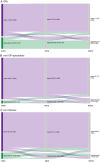Association between rural exposure/experience and practice location 10 years postgraduation, stratified by specialty: evidence from a cohort study of graduates from nine Australian universities
- PMID: 38889942
- PMCID: PMC11191762
- DOI: 10.1136/bmjopen-2024-086850
Association between rural exposure/experience and practice location 10 years postgraduation, stratified by specialty: evidence from a cohort study of graduates from nine Australian universities
Abstract
Objective: This study aims to determine the associations between specialty type and practice location at postgraduate year 10 (PGY10), matched with PGY5 and PGY8 work locations, and earlier rural exposure/experience.
Design and setting: A cohort study of medicine graduates from nine Australian universities.
Participants: 1220 domestic medicine graduates from the class of 2011.
Outcome measures: Practice location recorded by the Australian Health Practitioner Regulation Agency in PGY10; matched graduate movement between PGYs 5, 8 and 10 as classified by the Modified Monash Model, stratified by specialty type (predominantly grouped as general practitioner (GP) or non-GP).
Results: At PGY10, two-thirds (820/1220) had achieved fellowship. GPs were 2.8 times more likely to be in non-metropolitan practice (28% vs 12%; 95% CI 2.0 to 4.0, p<0.001) than graduates with non-GP (all other) specialist qualifications. More than 70% (71.4%) of GPs who were in non-metropolitan practice in PGY5 remained there in both PGY8 and PGY10 versus 29.0% of non-GP specialists and 36.4% of non-fellowed graduates (p<0.001). The proportion of fellowed graduates observed in non-metropolitan practice was 14.9% at PGY5, 16.1% at PGY8 and 19.0% at PGY10, with this growth predominantly from non-GP specialists moving into non-metropolitan locations, following completion of metropolitan-based vocational training.
Conclusions: There are strong differences in practice location patterns between specialty types, with few non-GP specialists remaining in non-metropolitan practice between PGY5 and PGY10. Our study reinforces the importance of rural training pathways to longer-term work location outcomes and the need to expand specialist vocational training which supports more rural training opportunities for trainees outside general practice.
Keywords: health services accessibility; health workforce; medical education & training.
© Author(s) (or their employer(s)) 2024. Re-use permitted under CC BY-NC. No commercial re-use. See rights and permissions. Published by BMJ.
Conflict of interest statement
Competing interests: None declared.
Figures


References
-
- Department of Health . Department of health. National medical workforce strategy 2021-2031. 2021. Available: https://www.health.gov.au/our-work/national-medical-workforce-strategy-2...
-
- Department of Health and Aged Care . About Australia’s rural health workforce, 2021. Available: https://www.health.gov.au/topics/rural-health-workforce/about
MeSH terms
LinkOut - more resources
Full Text Sources
